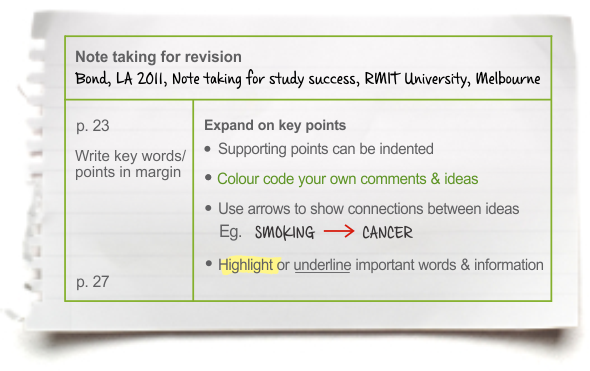Note-taking
Note-taking is an active process that enhances your ability to concentrate and learn. Good notes are structured, so they can be used for all study purposes including revision, assignment writing and exam preparation.
Have a clear purpose
Before you start taking notes, think about:
- Identifying the purpose of your note-taking. Are you trying to gain a basic understanding of a topic or are you reading in detail for an assignment?
- Using efficient reading strategies to gain a general understanding of the topic.
- Skimming the text to identify relevant information. Look at Reading skills.
Features of good notes
Efficient and effective notes:
- are organised into key ideas and supporting ideas
- use bullet points
- use visual techniques, e.g. highlighting, graphics, colours, and underlining to identify main points
- use abbreviations and symbols to show connections between ideas.
- Set a wide margin for key points and page numbers.
- Head the page with topic, date and record all bibliographic details, i.e. author, title, page no, publisher.
- Record your own thoughts in another colour.
Example

- Create a row across: [title: Note taking for revision:] write a short description including: Authors name, date, title.
- Create a side column 1/4 of the grids width: Use this area to note the page number, and write key words/points
- Remaining 3/4 of the grids space: Expand on key points noted from the side column.
Using abbreviations
Abbreviations are useful because they:
- save time
- connect key points.
Use standard abbreviations and develop your own. Shortening commonly used words is also a way to save time when note-taking.
Common abbreviations
| Meanings | |
| causes / leads to | → |
| an increase | ↑ |
| greater than | > |
| a decrease | ↓ |
| and | & |
| equals | = |
| is not equal to | ≠ |
| positive | + |
| less than | < |
| Meanings | ||
| for example | eg | |
| concerning / about | re | |
| note well | NB | |
| therefore | ∴ | |
| that is | ie | |
| and others | et al | |
| negative | -ve | |
| compared with | cf | |
Changing text to key points
Look at the following paragraph, which has key and minor points identified.
Bottleneck problemsThere is a limit to the amount of information that can be transferred from short-term memory to long-term memory. Only 5-7 pieces of information can be remembered at one time. This limited capacity of the long-term memory to absorb information to be stored is known as the bottleneck problem. In practical terms this means for example, that after reading a chapter of a text book, only 5-7 pieces of information can be effectively remembered and everything else will be forgotten. Chunking is a very useful technique for getting around the bottleneck problem. This means organising many smaller bits of information into fewer, larger bits. In other words, think of one complete wall instead of thinking 200 bricks. Therefore, it is essential to develop strategies for organising the information in a way that will make it easier for the brain to cope with.
There is a limit to the amount of information that can be transferred from short-term memory to long-term memory. [minor point: Only 5-7 pieces of information can be remembered at one time]. This [key point: limited capacity] of the long-term memory to absorb information to be stored is known as the [key point: bottleneck problem]. In practical terms this means for example, that after reading a chapter of a text book, only 5-7 pieces of information can be effectively remembered and everything else will be forgotten. [key point: Chunking] is a very useful technique for getting around the bottleneck problem. This means [key point: organising many smaller bits of information into fewer, larger bits]. In other words, think of [minor point: one complete wall instead of thinking 200 bricks]. Therefore, it is essential to develop [minor point: strategies for organising the information] in a way that will make it easier for the brain to cope with.
Now, look at how the information has been organised into key points and minor points.

Key points
Bottleneck problem = limited memory capacity
Minor points
- Only 5-7 info at once: all else goes!
- Need strategies to organise info
How to remember -> chunking.
Organise small bits to larger bits = one wall not 200 bricks!
What's next... Note taking in classes and lectures
